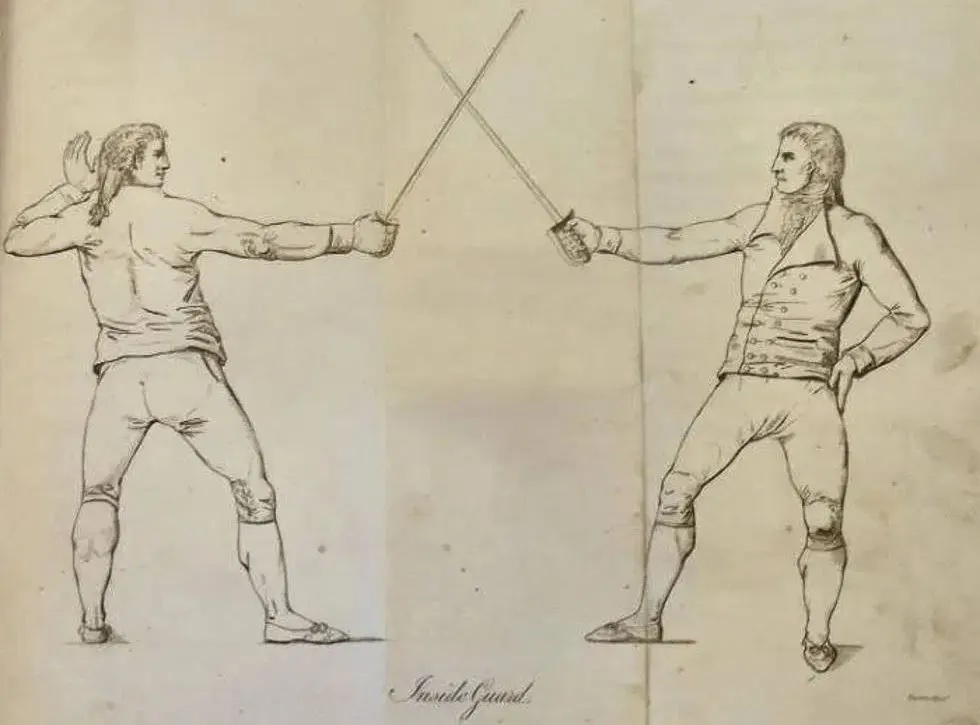Classes topics
The classes are divided in 2 mains parts: civilian and military fighting. The “civilian” lessons focus on self-defense weapons and bare hands fighting while military focus on typical infantry weapons like saber and bayonet.
About saber:
Study and practice of the infantry saber (18th and 19th century). The bases taught are coming from British sources of the “napoleonian” era, mostly from Charles Roworth and Henry Angelo. Nonetheless, other sources and periods will be studied, from time to time, to enrich the practice. A large part of the classes will be dedicated to the sparring.
There is room as well for more experienced practitioners to propose exercises to practice together as well as some aspects of the sources they want to dig in deeper.
Main weapons:
- Saber
- Walking Stick
- Light Staff
- Bare Hands (percussive)
Main styles:
- English Saber (Roworth & Angelo)
- Spanish Saber (Late Destreza)
- Savate – French Boxing (Lecourt et Charlemont)
- French walking stick ((Lecourt, Charlemont)
- Light staff (“Joinville” style)
- Bartitsu – Mix of Jiujitsu, walking stick (Vigny style)
Secondary styles: (related to main styles)
- Staff and polearms XVIth (Source: Meyer) – viewed as ancestor of light staff and baïonette weapons
Future additions:
- French wrestling (Main – XIXe) – Historical part of self defense of XIXth
- Street fighting (Main – XIXe) – Historical part of self defense of XIXth
- Knife (secondary – XIXe/modern) – Classical offensive weapon of XIXth
- Baïonnette (Main – XIXe) – Classical military weapon of XIXth
- Messer (secondary – XVIe) – Saber ancestor
Schedule & additional information
Monday evenings – 19:00 to 21:00
All year long, including during vacations
Adult lesson (from 15 years old)
Language: French by default (English & Flemish translation possible)
Equipment
To be noted:
Before any investment, do not be afraid to ask to different club members about gear quality, to see what’s worth or not. That will prevent you from spending money on worthless elements.
Equipment to start with

We require that you equip yourself and quickly with the following elements:
- Yourself
- A practice outfit both comfortable and practical
- Hands “light” protection (bikes gloves like)
- Groin protector (optional)
The Next Steps
These are the elements that you will add to your kit over time (roughly sorted by priority) :
- A fencing mask (ideally a HEMA dedicated model)
- Back of head protection (with or without mask overlay)
- Medium protection gloves
- Forearm & elbow protection
- Weapon simulator depending on you affinities: (all fully optional)
- Defensive walking stick (90-100cm, <500g)
- Light staff(<160-200cm, <800g)
- Heavy staff
- Saber and/or Rapier
Sources
- The Bartitsu Compendium, Volume 1: History and the Canonical Syllabus, Tony Wolf (Lulu.com) (2005)
- The Bartitsu Compendium, Volume II: Antagonistics, Tony Wolf (Lulu.com) (2010)
- Manuel de Boxe et de Canne, Emile André (1904)
- L’Art de la Boxe Française: Nouveau Traité Pratique et Théorique, Joseph Charlemont (1899)
- 100 façons de se défendre sans arme, Emile André (1905)
- 100 façons de se défendre avec armes, Emile André(1905)
- Cahier H Baton de Joinville, FFSBF&DA/CNCCB (2018)
- DVD Bartitsu: Historical self defense with walking stick according to Pierre Vigny, Agilitas.tv (vimeo)
- Nouvelle théorie du jeu du jeu de la canne, M. Laribeau (1856)
- Art of defense on foot, 4th edition. 1824. Charles Roworth
- The Rules and Regulations for the Infantry Sword Exercise. 1817. Henry Angelo
- Angelo’s posters
Sources in study:
- The Bartitsu Compendium, Volume III: What Bartitsu Was and What it Can Be, Tony Wolf (2022)
- The Walking Stick Method of Self Defense, H.G. Lang (1923)
- Théorie de l’escrime a la baïonette, Joseph Pinette (1848)
Instructors
Benjamin Dal
Instructor of stick and staff
TBD
Jeremy Royaux
Instructor of saber and rapier
Firstly interested in combat sports and self defense, he discovered HEMA through a friend and became highly passionate in it since. He keeps on practicing longsword at the Salle d’Armes Jean le Noir / . Bruselas Destreza. When he is not busy practicing HEMA, he accompagnies delinquent minors in Brussels on their psycho-education (restorative/reparative justice) and also is invested in science popularization in another association.
Ressources
Generics:
Acta Periodica Duellatorum: regular publication of scientific articles covering the domains of HEMA
Resources for the Historical European Martial Arts and Sports Community: articles, sources, ressources, informations
Saber:
History Saber Suite youtube channel – offers many interesting videos about saber, its history and its uses
Academy of Historical Fencing videos introducing the bases of saber (Roworth / Angelo)
Example of high level saber sparring (more Polish saber in this instance)
Example of high level saber sparring (Roworth / Ang
